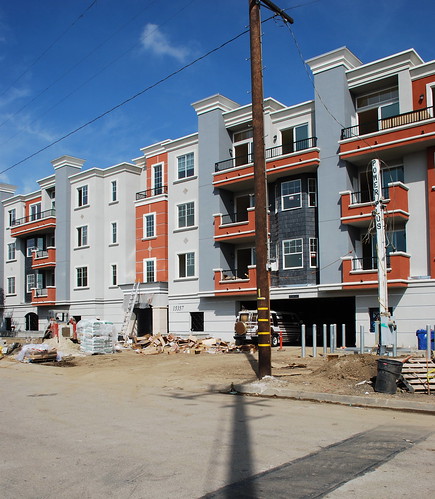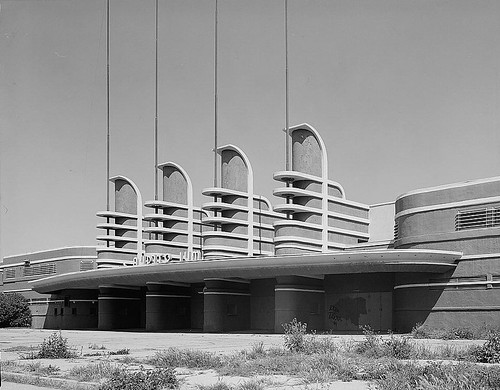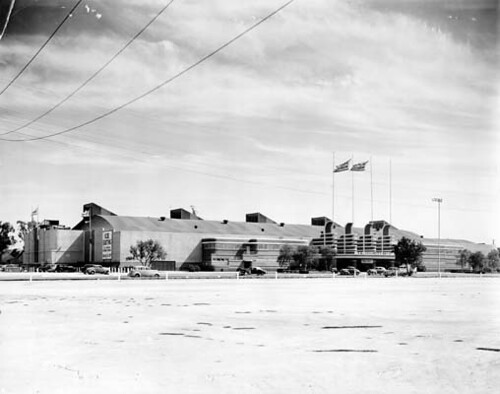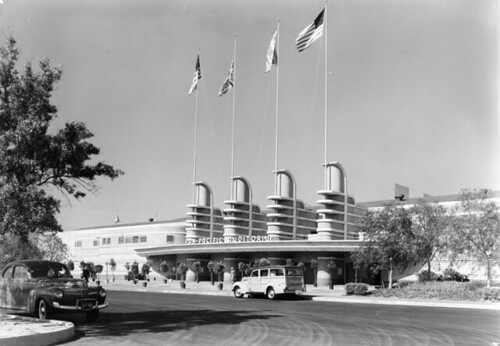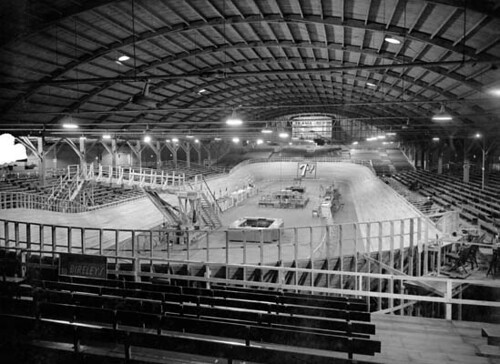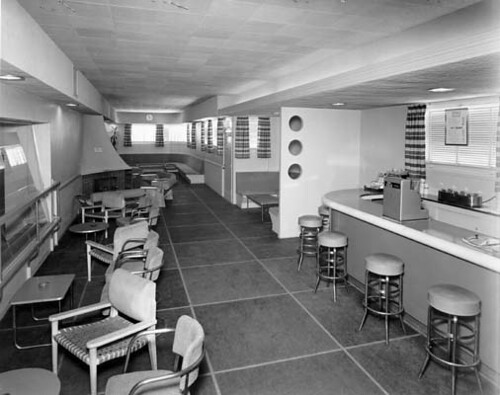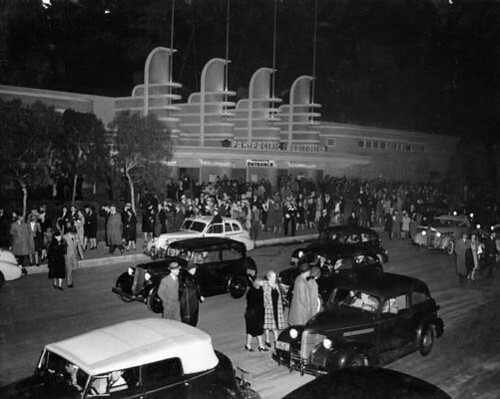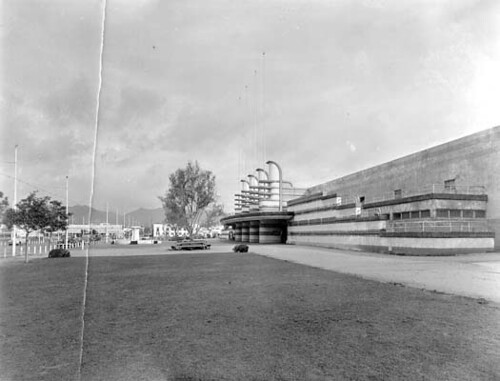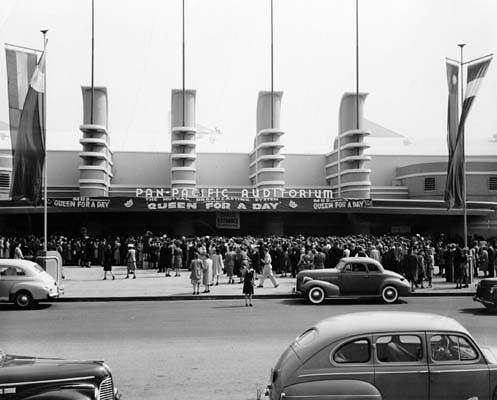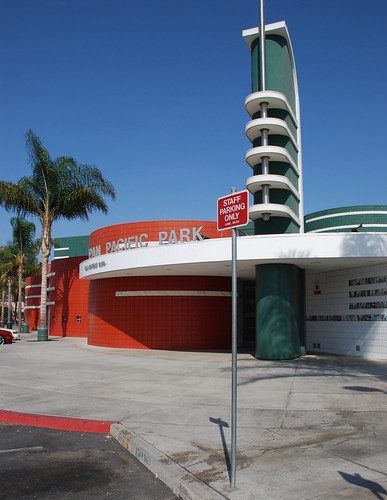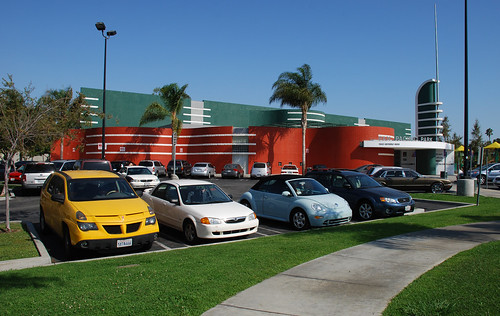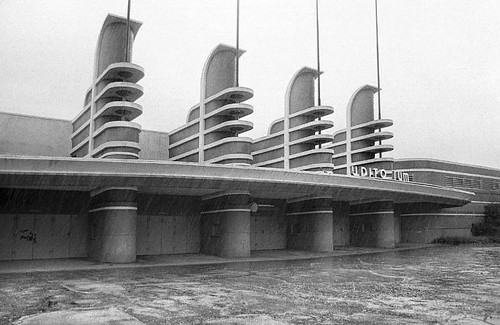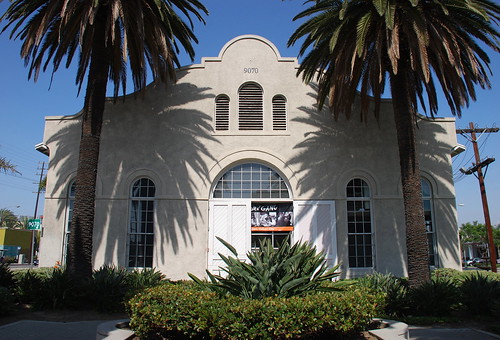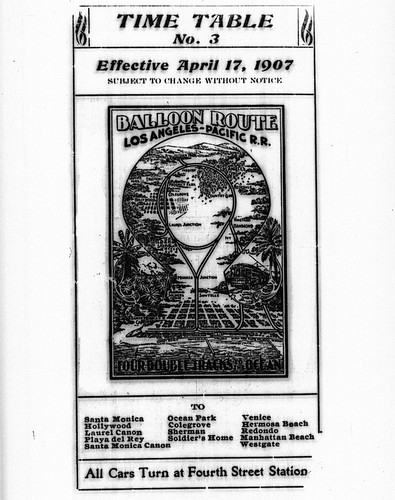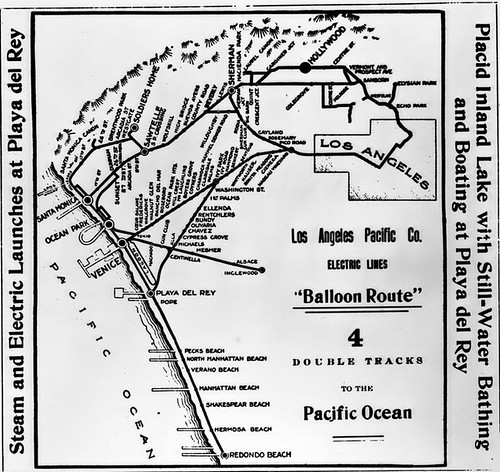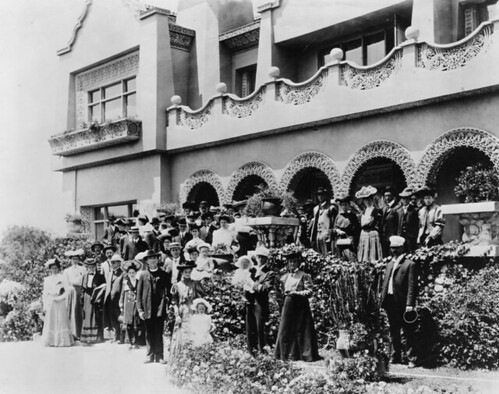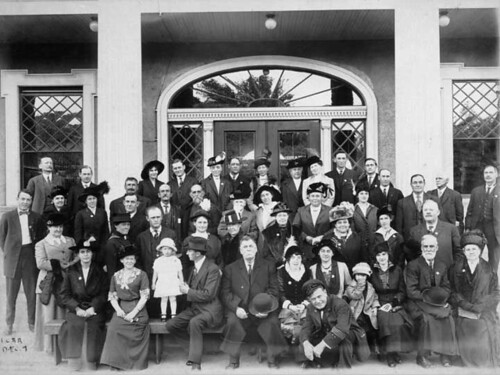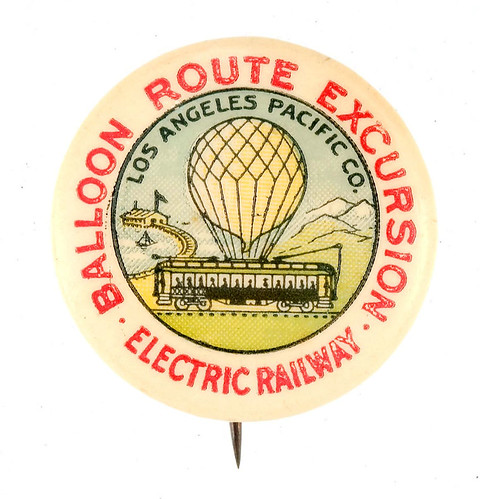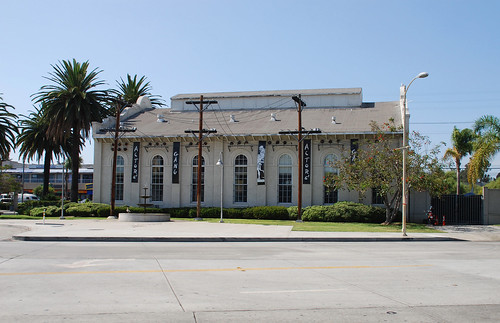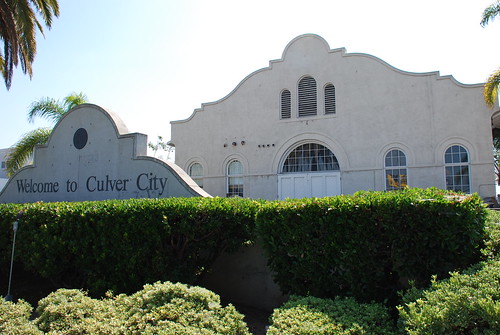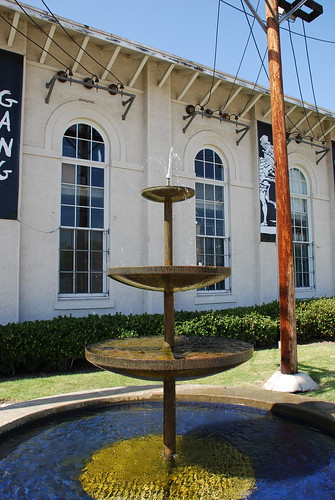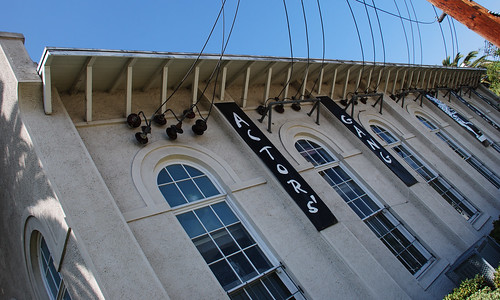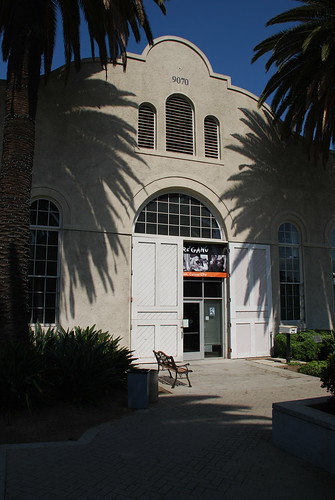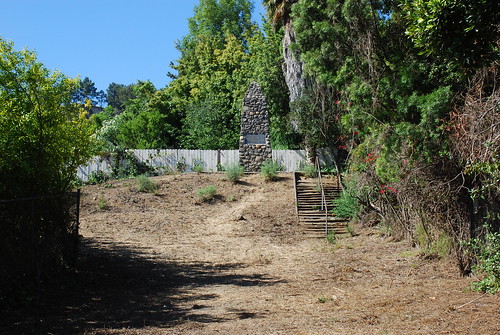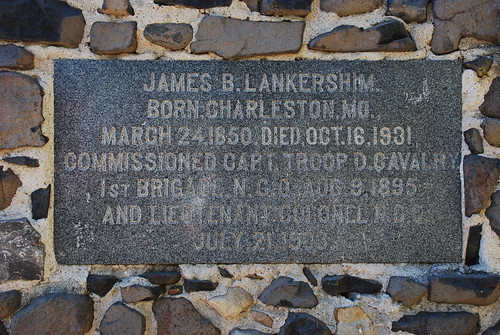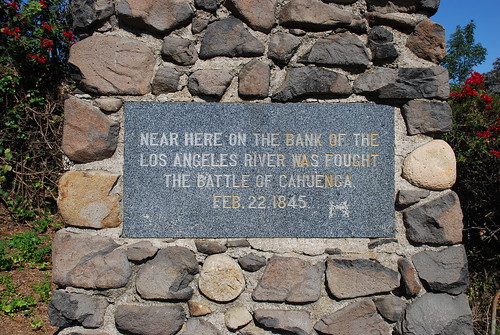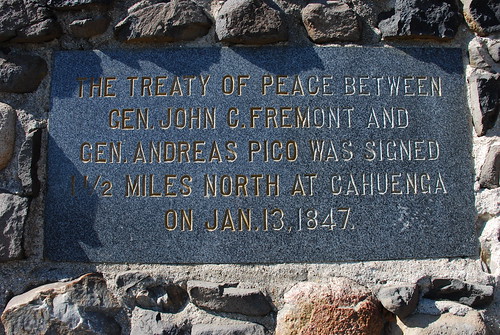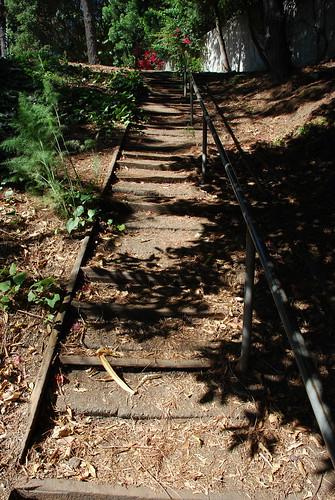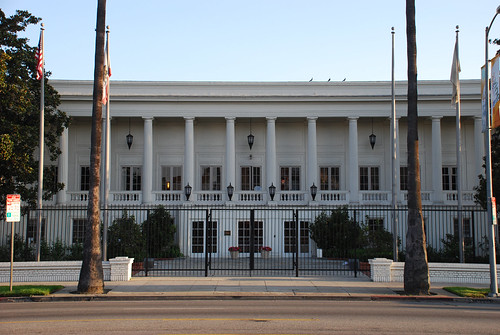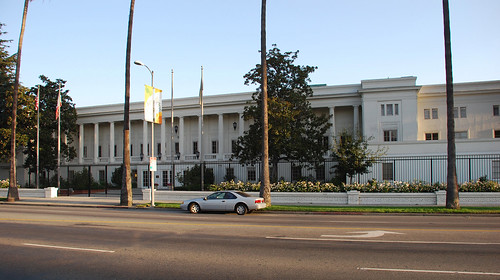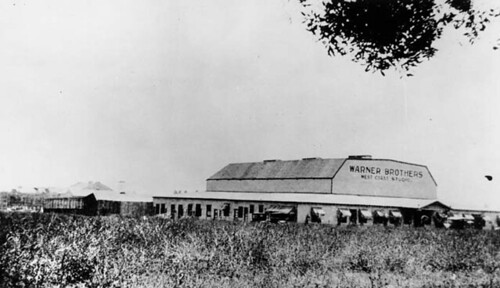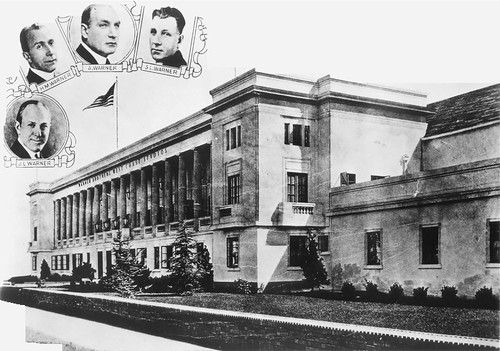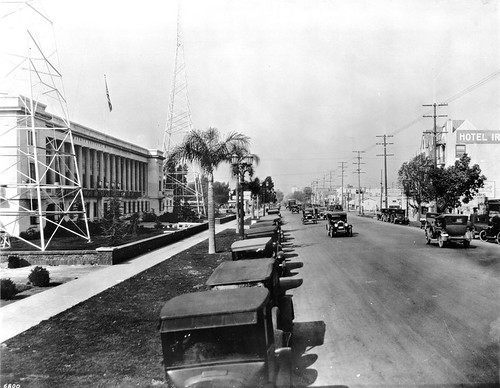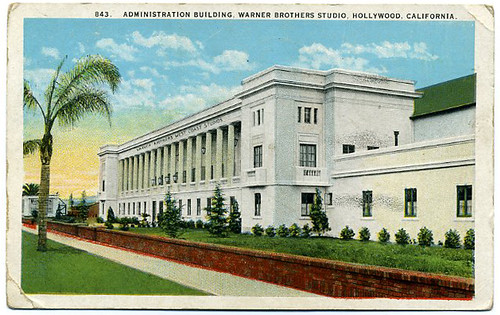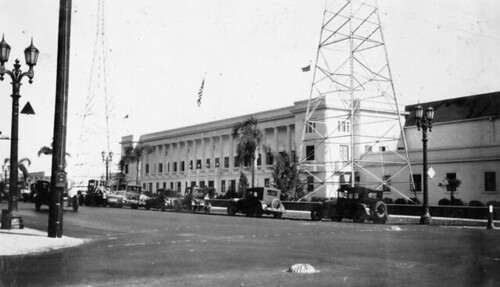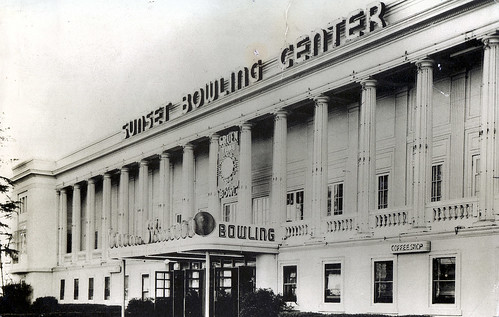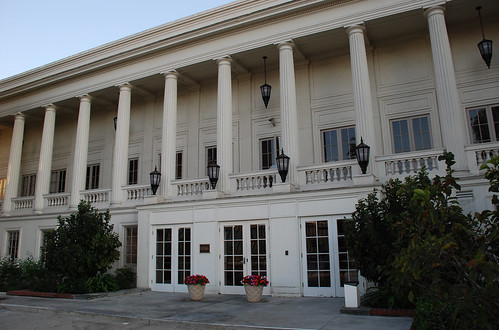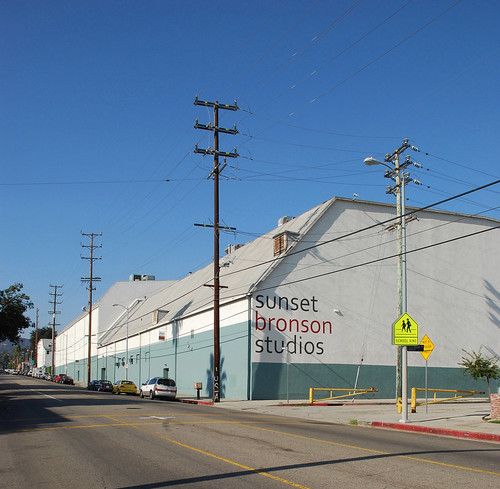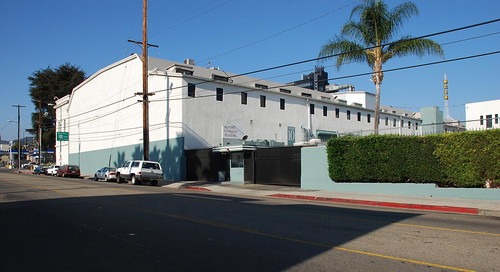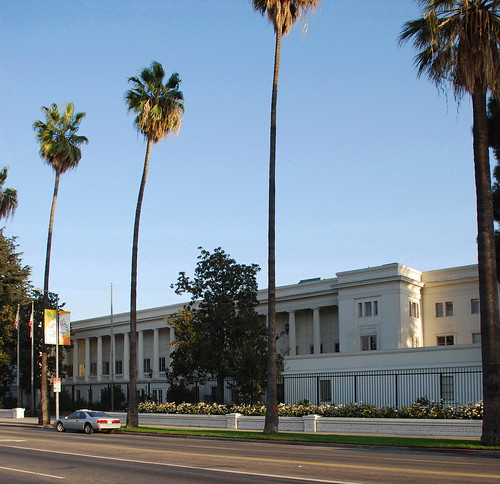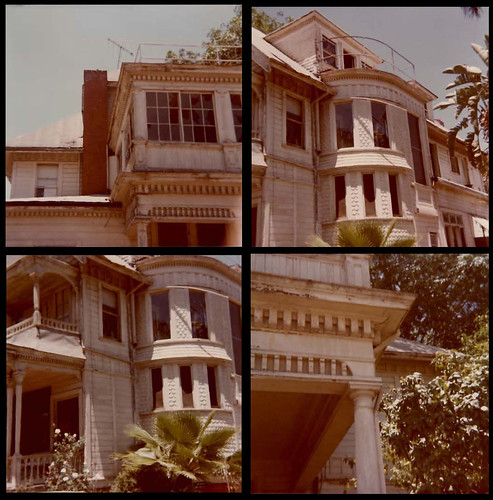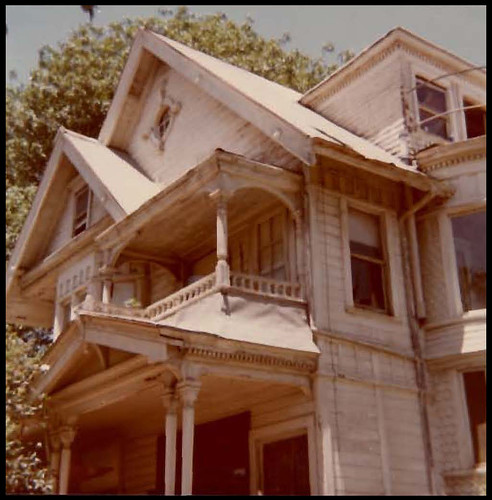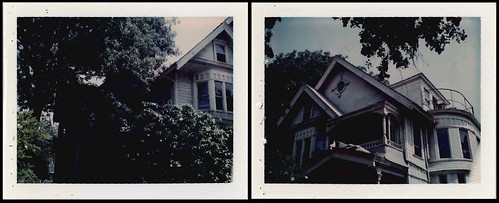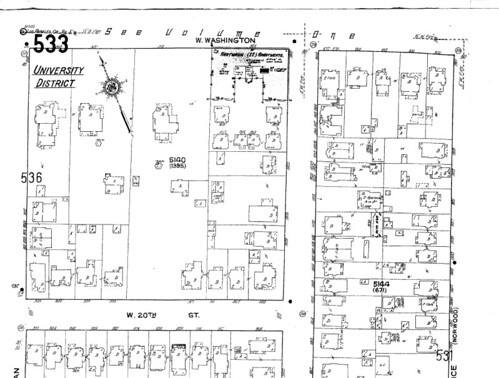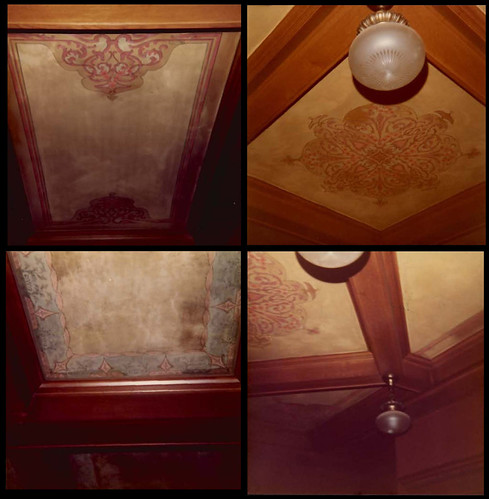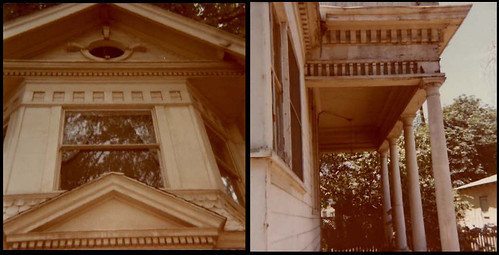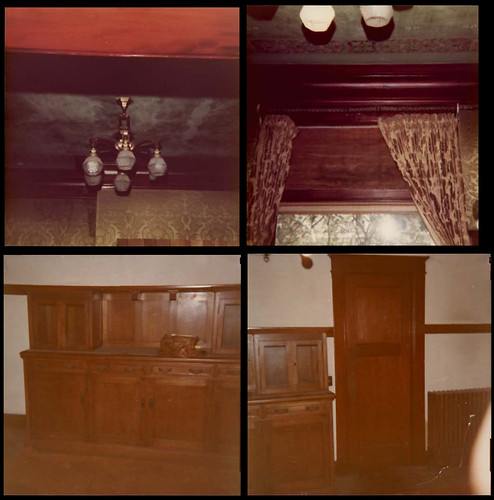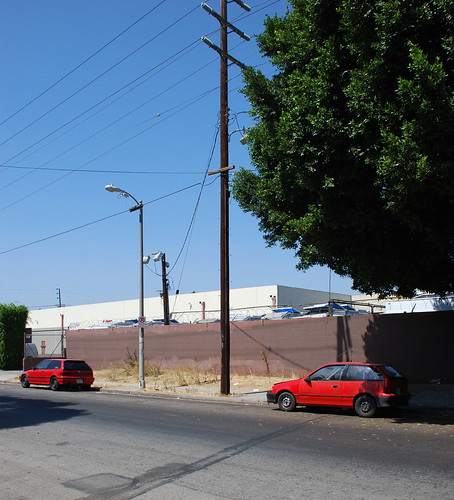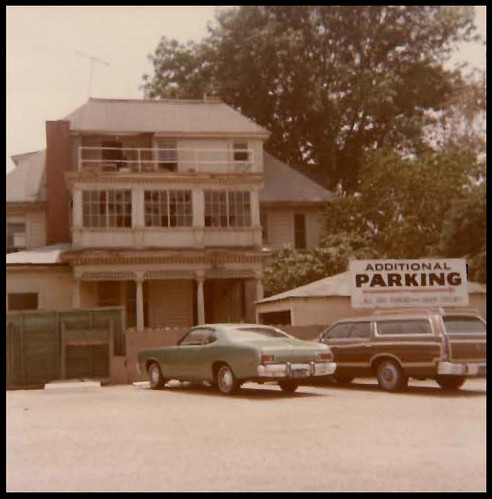Monday, September 29, 2008
No. 185 - (Site of) President's House
(Site of) President’s House
1912 – Octavius Morgan
7851 Budlong Avenue – map
Declared: 4/19/78
What’s the deal? This is the third Los Angeles Historic-Cultural Monument in a row about which I can only speak in the past tense. Not only that, pictures of it are few and far between.
When Patricia Connolly died in 1887, the 160 Southern California acres she had called home since 1868 went to her son (or possibly her brother, depending on which source you cater to), Joseph Patrick Connolly. It was he who, in 1912, hired the founding president of the Southern California chapter of the American Institute of Architects, Octavius Morgan, to build this eighteen-room, 14,850-square-foot, Mission Revival mansion for a cost of $75,000 (we’ll see lots more of the architect’s works throughout the list of HCMs as part of Morgan, Walls, and Clements). There were tennis courts outside, a bowling alley in the basement, and billiard and snooker tables upstairs. The home was noted for its rich mahogany paneling, gorgeous tile work, crystal chandeliers, grand fireplaces, and stained-glass windows. Connolly also kept a lake at what is now Normandie between 78th and 83rd Streets stocked with ducks and fish. Joseph P. Connolly died in 1929, leaving the estate to his son and daughter, who began selling off chunks here and there.
By 1937, the estate had been whittled down to just thirty-five acres. This is when George Pepperdine, having made his money as the founder of the Western Auto Supply Company back in the oughts, bought the property for $150,000 to begin the Christian college that would become Pepperdine University.
Undergoing only relatively minor changes (i.e. one bedroom and French doors in the breakfast room), the former Connolly home was used as the university’s administration building, then for holding classes, community and social events, and housing for both chancellors and students.
Pepperdine University broke ground on its Malibu campus in 1971, and by the end of the 1976 school year, most regular classes and departments had been moved to the new location. After some interest to turn the property into low- and mid-income housing didn’t materialize, the Crenshaw Christian Center, run by the Rev. Frederick K.C. Price, bought the old campus, now thirty-two acres, in 1981 for a cool $14 million. By this time, Pepperdine had been using the Vermont Knolls campus as the administrative headquarters of the schools of education and business management. Having failed to buy a 23-acre plot from the Inglewood Unified School District the year before, the church immediately announced plans to build on its new property a 10,000-seat sanctuary to house its extremely large congregation. The problem was, the President’s House – the old Connolly residence – was in the way.
The church applied for a permit to raze the seventy-year-old mansion in the summer of 1982. Now, in any other circumstance, the Center would’ve gone ahead and torn down the building, but the city had declared the mansion, its carriage barn, and formal gardens an L.A. landmark in 1978.
To its credit, the church offered the building – for free – to anyone who would come and take it. For a bit, it looked as though a podiatrist was going to move the monument to an eight-acre plot in Northridge for use as his home. That never happened, obviously. Too bad that while there were ultimately about 400 potential takers, the $600,000 cost, including the price of a new site, proved too prohibitive. A demo permit was issued in July 1986, and the razing began.
I had considered driving down to the old campus, if only to get a picture of the 10,146-seat FaithDome, the ginormous geodesic dome occupying the site of the landmarked President’s House since 1989. In the end, though, I didn’t feel like it. I remember first seeing the dome from twentyish miles away on my regular weekend hikes to the Hollywood Sign when I first moved to L.A. (I also recall asking a friend what sports team played there). I’m not convinced I need to see it up close.
Clearly, I couldn’t dig up a whole lot of pictures of the Pepperdine President’s House (the one at the post’s beginning is, as is often the case, from the L.A. Department of City Planning website). If anyone out there has any old photos of the landmark – inside or out – I sure would like to see them.
Sources:
Roderick, Kevin “Pepperdine Sells Original Campus for $14 Million” The Los Angeles Times; Jun 27 1981, p. A1
Ryon, Ruth “Pepperdine House To Be Given Away” The Los Angeles Times; Aug 15 1982, p. G2
“Women Builders Win Contract for Mansion” The Los Angeles Times; Dec 12 1982, p. J9
Chazanov, Mathis “Church’s Prayers May Be Answered soon with Permit To Build Sanctuary” The Los Angeles Times; May 5 1986, p. Metro 1
Up next: Morgan House (Harbor Area Y.W.C.A.)
continue reading...
Posted by
Floyd B. Bariscale
at
9:59 PM
3
comments
![]()
Labels: South Los Angeles
Saturday, September 27, 2008
No. 184 - (Site of) Tower of Wooden Pallets
(Site of) Tower of Pallets
1951 – Daniel Van Meter
15357 Magnolia Boulevard, Sherman Oaks – map
Declared: 4/19/78
“I have a place where it is quiet, despite the apartments, the noise of the boulevard, and the hum and screeches of the rat race on the freeway 200 feet away… To me, this is a spiritual place.” – Daniel Van Meter
I can’t imagine we’ll see a more dubious Historic-Cultural Monument in Los Angeles than this stack of 2,000 pallets out in Sherman Oaks. Actually, we won’t even see HCM No. 184 any more, either, as another unsightly apartment complex is currently being built on the site.
Daniel Van Meter had a colorful past. His dad, James (d. 1938), was the chemist who invented the chloro-cyanic gas used in World War 1, to hilarious effect. Chums with Edison, Burbank, Marconi, Steinmetz, and Tesla and a protégé of Mexican President General Porfirio Diaz, the elder Van Meter introduced liquid chlorine to the U.S., concocting it at his Deutsche Chlorine Works in Germany. Daniel’s mom, Esther (d. 1954), was a great-granddaughter of John Quincy Adams.
In April 1942, Daniel and two of his four brothers, James and Baron, surrendered to the man on charges of sedition under the Subversive Organizations Registration Act. The trio, which was operating a goat, chicken, and rabbit ranch at 2180 West Adams Boulevard at the time, was busted for failing to register as members of Robert Noble and Ellis O. Jones’s “Friends of Progress”, a group that allegedly supported the overthrow of the U.S government while having ties to the pro-Nazi German American Bund. Baron (who became a well-renowned beer-can collector –Beer Can Collector of America #418! – and square dancing’s “Cacti Pete”, having the distinction of having attended every single National Square Dance Convention from 1951 to 2002!) and Daniel (who went on to co-found the American Independent Party in the 1960s) did time for their political beliefs, with the Dan landing in San Quentin. While a District Court of Appeals later reversed the conviction, the brothers’ demands in lost wages and damages were denied.
In 1951, when union workers at a local Schlitz Brewing Company plant refused to repair thousands of junky 3'x3'x6" pallets, the enterprising Daniel Van Meter saw his chance and he took it. Using the five truckloads of discarded pallets, he began to build his monument in his backyard on Magnolia Boulevard off Sepulveda. Van Meter had moved to the property in 1947. The land was once part of an apricot ranch owned by actress Louise Fazenda (you may remember her from such films as Schultz the Paperhanger, Tea: With a Kick!, and Are Waitresses Safe?). Going back to the 1800s, the land was owned by the McMasters family. The Van Meter boys (Baron moved there, too) ultimately turned their land into a veritable junkyard – later visitors mentioned seeing there a dozen scrapped cars, a gas pump, a 1938 city bus, washing machines and water heaters, an old outhouse, a battleship turret, and wooden wagons, not to mention the menagerie of cats, dogs, chickens, turtles, pigeons, and a raccoon.
Taking Van Meter two years to build, the Tower of Pallets, when finished, reached twenty-feet tall and twenty-two-feet wide at its base. There was a thirteen-foot wide opening at the top. The open room inside, full of patio furniture and all sorts of detritus, according to legend, marked the grave of a three-year-old who died and was buried there in 1869. Soon after Daniel finished the tower, building inspectors arrived and, stumped, classified the giant pallet cone as a fence. (The picture leading off the post is from the L.A. Dept of City Planning website.)
In 1977, the city’s fire inspectors declared the tower “an illegally stacked lumber pile” and ordered the structure torn down. Van Meter, though, somehow convinced the Cultural Heritage Commission and the city of L.A. to declare his twenty-five-year-old creation HCM No. 184, pushing off demolition until Van Meter moved or died. (Robert W. Winter, who voted for the tower’s designation when he was a commissioner, later explained the monument conferral with, “Maybe we were drunk.”)
Daniel Van Meter died in June 2000 at the age of 87. Three years later, developers Westgate Group Inc. had in hand a demolition permit for the old Van Meter home. However, since the landmarked tower was protected, the developers had to get the city’s okay for its razing (or what was left of it – it had dwindled to about five-feet tall by 2002, according to Steve Harvey), which it did in early 2005. Today, construction on a new, 98-unit apartment building on the site of the Tower of Pallets (click on that link for a picture of Daniel and a chicken along with quotes to make you cringe) is almost finished (so, did they find the body of a 140-year-old three-year-old?).
Here’s what the prescient Van Meter wrote thirty years ago when lobbying for his tower’s landmark status:
“… in a few years this piece of the good earth may be covered by apartments for the storing of surplus people. In the meantime, pray, let this strange structure be, let it continue to be a haven of rest for an individual – that endangered species – who once knew how sweet was our Valley.
“Noted Inventor Burial Planned” The Los Angeles Times; Jan 23, 1938, p. A6
“Noble Called Racketeer by Former Associate” The Los Angeles Times; Feb 25, 1942, p. A1
“Brothers Seek Arrest in Vain” The Los Angeles Times; Apr 16, 1942, p. 15
“Noble Aids Go on Trial Today” The Los Angeles Times; Jul 6, 1942, p. 6
“Seven Denied Damages by State Board” The Los Angeles Times; Nov 28, 1946, p. 10
“Rites Set Today for Mrs. Esther Van Meter” The Los Angeles Times; Jul14, 1954, p. B8
Simon, Richard “Tower of Tranquility Unusual Sherman Oaks Landmarks Provides a Refuge from Turmoil” The Los Angeles Times; Feb 15, 1988, p. 8
Simon, Richard “For a Collector, His Is an Odd Pallet” The Los Angeles Times; Feb 19, 1988, p. 3
Harvey, Steve “Only in L.A.; The Valley’s Once-Mighty Tower of Pallets Has Fallen on Hard Times” The Los Angeles Times; Nov 14, 2002, p. B4
Garrison, Jennifer “Does It Stack Up as Art?” The Los Angeles Times; Jan 26, 2005, p. Metro A1
Up next: (Site of) President’s House
continue reading...
Posted by
Floyd B. Bariscale
at
11:05 PM
5
comments
![]()
Labels: North Sherman Oaks/Van Nuys
Monday, September 22, 2008
No. 183 - (Site of) West Facade of the Pan Pacific Auditorium
(Site of) West Façade of Pan-Pacific Auditorium
1935 – Plummer, Wurdeman & Becket
7600 Beverly Boulevard – map
Declared: 3/1/78
The architectural firm of Plummer, Wurdeman & Becket created the Pan-Pacific Auditorium as a temporary structure, initially serving the National Housing Exposition’s run for a few weeks during the summer of 1935. The big barn, however, went on to host all sorts of tradeshows, concerts, sporting events, circuses, horse shows, roller derbies, and political rallies, before being shuttered in 1972.
A massive (400' x 250' with eighteen 130-foot arch-rib trusses and 110,000 feet of floor space) wood-frame, stucco-covered building, the auditorium was the centerpiece of the twelve-and-a-half-acre exposition grounds off Beverly and Fairfax, just east of Gilmore Stadium. The outstanding feature of the Pan, of course, was the Streamline Moderne façade, with its four green and white pylons and soaring flagpoles. With Wurdeman in charge, the architects created one of Los Angeles’s most iconic landmarks in the Depression years. (Charles F. Plummer would die four years later. Walter C. Wurdeman and Welton D. Becket then teamed up to design buildings all over the southland. After Wurdeman's death, Becket worked on the Capitol Records Building and the Music Center downtown.)
Built in just fifty-six days, the Pan-Pacific Auditorium opened May 18, 1935, as “the largest of its sort in the West and one of the three largest in the nation.” The 500-member Tenth Olympiad Chorus sang at the dedication ceremonies that Saturday night.
In the 1940s, the Pan-Pacific became a permanent full-service auditorium. The concrete slab floor was claimed to be the “world's largest indoor ice rink.”
If you were a kid in Los Angeles in the 1960s, there’s a good chance you saw the Harlem Globetrotters, the Ice Capades, or a circus or two here. The Pan was also the site of Elvis Presley’s first west-coast concert. Q: How awesome would it have been to see Elvis with Scotty Moore, Bill Black, and D.J. Fontana and the Jordanaires perform here? A: Very awesome, indeed. And for $3.75 (cheap!), too. Click here for thorough coverage of his October 1957 visit.
A cafe in the auditorium.
Along with the Grand Olympic and Shrine auditoriums, the Pan-Pacific became one of Southern California’s major indoor sports facilities. Besides supporting college and two pro hockey teams, the Pan saw its share of home UCLA basketball games. It was also the home court of the USC men’s basketball team from 1949 through 1959.
The Southern California Chapter of the American Institute of Architects gave the Pan-Pacific an Honor Award in January 1947.
In 1959, the air-conditioned L.A. Memorial Sports Arena opened and the slow death knell began for the Pan. It continued on for another thirteen years, closing in 1972. The county purchased the property in 1979, a year after it was both declared a city landmark and listed on the National Register of Historic Places, and a year before it made an appearance with Olivia Newton-John in Xanadu.
In April 1988, the county of L.A. unveiled plans to incorporate the auditorium into a 116,700-square-foot retail and entertainment complex. Costing more than $14.5 million, the center would include a movie theater, food court, a couple of restaurants, an ice rink, gym facility, and office and retail space. However, a year later, on May 24, 1989, a little after 7:00 p.m., the dilapidated Pan-Pacific Auditorium burnt to the ground, the work of an arsonist. More than 200 firefighters battled the blaze, but the wooden structure went up fast, with the last of the four fin-shaped towers falling a little after 10:00 p.m. (see page 228 in McGrew and Julian’s Landmark of Los Angeles for a picture of the crumbled pylons.) Officials arrested a 42-year-old transient who, despite confessing to starting the fire, was released by the end of the month due to lack of evidence.
The remains of the façade stood until May 1992 when they were cleared away for the new elements to Pan Pacific Park, the Pan Pacific Recreation Center (with its single-towered homage to the old landmark) and, later, Renee’s Place, a universal-access playground dedicated this past spring to Renee Weitzer, Chief of Staff and Planning Deputy in Council District 4. The park falls under the jurisdiction of the city’s Recreation and Parks Department.
Today's Pan Pacific Recreation Center.
The black and white shots here, except for the top one, are from the Los Angeles Public Library. That first one is from the Library of Congress. For a trio of color shots of the Pan in 1980, click here to see Larry Gassan’s Flickr photographs.
Sources:
“Huge Auditorium Construction” The Los Angeles Times; Apr 21, 1935, p. 15
“Great Exhibit Nearly Ready” The Los Angeles Times; May 12, 1935, p. D3
“Crews Rush Homes Show” The Los Angeles Times; May 12, 1935, p. 27
“House Show on Tonight” The Los Angeles Times; May 18, 1935, p. 4
Gollner, Philipp “Plan for Historic Pan Pacific Features Rink, Movie Theaters” The Los Angeles Times; Apr 30, 1988, p. Metro, 2
Stein, George and Nieson Himmel “fire Destorys Pan Pacific Auditorum” The Los Angeles Times; May 25, 1989, p. 1
Schrader, Esther and Patt Morrison “Like Debut in 1935, the Pan’s Finale Was a Spectacle” The Los Angeles Times; May 25, 1989, p. Metrco1
Gustkey, Earl “The Pan-Pacific Fire Post-Moderne Building Was Scene of Exciting Times for L.A. Sports Fans” The Los Angeles Times; May 26, 1989, p. Metro 1
Up next: Tower of Wooden Pallets
continue reading...
Posted by
Floyd B. Bariscale
at
9:28 PM
13
comments
![]()
Labels: Wilshire
Sunday, September 14, 2008
No. 182 - Ivy Substation
Ivy Substation
1907
9070 Venice Boulevard – map
Declared: 2/1/78
The Los Angeles Pacific Railway built this Mission Revival substation at the junction of three rail lines – the Redondo Line, the Venice Short Line, and the Santa Monica Air Line. Named after the real estate tract Ivy Park (absorbed when Culver City incorporated in 1917), the substation was constructed in the summer of 1907, a year after the Southern Pacific became the Pacific Railway’s majority owner. As one of the company’s largest substations, converting AC to DC, the substation most famously powered the company’s Balloon Route Trolley Trip tourist line. Now I have to find out what the Balloon Route Trolley Trip was…
The Electric Railway Historical Association of Southern California tells us the Balloon Route “was the most famous trolley trip in the west.” In an old interview, Mr. C.M. Pierce, former owner of the Glen-Holly Hotel at Yucca and Ivar Streets in Hollywood, said he took over managing the under-promoted Balloon Route Trolley Trip on Thanksgiving Eve in 1904. Pierce, through “advertising bombardments”, grew the route’s excursions from just one car to as many as eighteen carloads a day. It was parlor car No. 400, formerly General Moses H. Sherman’s private car, which led the excursions for years and which Pierce had rented for $15.00 a day.
The route covered more than 101 miles for the cost of one hundred cents (i.e. a dollar). All told, the Balloon Route excursion visited ten beaches and eight cities during its seven and a half hour trip. The railway called it the Balloon Route because the line’s loop was shaped like a big balloon, even though it clearly wasn’t, as evidenced in the map below.
(USC Digital Libraries Archive)
The trolley, complete with a white-capped guide, would take off out of the Hill Street Station downtown (originally out of the Fourth Street Station), passing “the main hotels, railroad offices, Court House, the old Spanish Plaza and Chinatown, the battle-ground of Generals Fremont and Pico, through the oil district and past the Sisters’ Hospital on Sunset Boulevard, and along the foothills to the famous Cahuenga Valley and that modern “Garden of Eden” – beautiful Hollywood”. Here, the trolley would stop at Hollywood’s first tourist attraction, the home of painter Paul de Longpre at the northwest corner of Hollywood and Cahuenga. Across the street from the house was a freight station where the cars would stand by while passengers would visit de Longpre. Here’s a picture of Balloon Route tourists posing in front of the house (demolished in 1925).
Posing at de Longpre's (L.A. Public Library)
At the National Soldiers' Home in Sawtelle (Alaska's Digital Archives)
The trolley traveled through Sherman (West Hollywood) and on to Sawtelle’s National Soldiers’ Home where the passengers would have another group photo taken (the photographer would race back to his lab, develop his film, and sell the photos to the tourists later that same day). After that, it was coastward through Westgate and Brentwood Park (“modeled after Golden Gate Park, San Francisco”) to Santa Monica and its Camera Obscura and Long Wharf. The trolley also visited Ocean Park for a ride on the roller coaster and Playa del Rey for a fish lunch. Passengers would check out “Venice of America” and Redondo’s pier and Moonstone Beach, too. The trip ended by taking the Air Line Route back to Palms where they’d watch some silent movies before heading back downtown.
Pierce operated dozens of Balloon Route trips from San Francisco to San Diego. After the “Big Merger” with the Pacific Electric in 1911, he went on to become the company’s Manager of Excursions, adding the Orange Empire, Old Mission, and Triangle Trolley Trips to his responsibilities.
The Ivy Substation last supplied juice to the Santa Monica Air Line’s sole daily round-trip passenger run in 1953. By the late 1970s, vacant for decades, the building had become “a home for pigeons and hobos”, with more than 300 transients living there. (There's a shot of the substation at its nadir on page 93 of McGrew and Julian's Landmarks of Los Angeles.)
In 1982, when the city of L.A., which had bought the building five years earlier, advertised it wanted commercial and nonprofit groups to submit bids to purchase or lease the substation, Culver City jumped in the following year and offered to lease the building and turn it over to a nonprofit organization. The two cities eventually did agree to a forty-year lease, but, with typical governmental swiftness, that wasn’t until 1987. Part of the deal called for Culver City to spend $1 million not only to renovate the building's interior, leaving its brick shell intact, but also to upgrade the adjacent two-acre Media Park, which Culver City had been trying to get its hands on since 1963.
“A copy of the metal fountain that recirculated water used to cool the machines inside.”
A $1.9 million rehabilitation project on the substation and park began in 1991. Milford Wayne Donaldson handled the renovation’s design and construction plans while the contractor was the Driver-Eddy Construction Company. The substation re-opened as a community center in April 1993, boasting a 3,500 square-foot main room.
“Fake power lines feed into the stuccoed exterior from fake power poles.”
Steven Ehrlich Architects and Matt Construction converted the old substation into a 99-seat theater in the fall of 2002. The resident company is Tim Robbins’s The Actors’ Gang. Maintenance and operation of the substation and park fall to the Culver City Redevelopment Agency.
The last major remaining structure built by the Los Angeles Pacific Railway Company, the Ivy Substation is also listed on the National Register of Historic Places.
Sources:
“Balloon Route Excursion Souvenir” June, 1907 Wood’s, Inc. Los Angeles, CA
Duke, Donald Pacific Electric Railway, Volume Four: The Western Division Golden West Books 2004 San Marino, CA
Mitchell, John L. “Culver Urges L.A. to Fix Rundown Red Car Building” The Los Angeles Times; Jul 17, 1983, p. WS1
Burbank, Jeff “Culver City to Lease Substation, Park” The Los Angeles Times; Nov 27, 1986, p. 1
Hirabayshi, Bernice “Getting a Line on History Redevelopment: Culver City Preserves a Dilapidated Red Car Power Substation by Converting It into a Community Center.” The Los Angeles Times; Apr 15, 1993, p. 1
Up next: (Site of) West Façade of the Pan Pacific Auditorium
continue reading...
Posted by
Floyd B. Bariscale
at
10:55 PM
1 comments
![]()
Labels: Palms/Del Rey/Mar Vista
Friday, September 12, 2008
No. 181 - The Burial Place of J.B. Lankershim
The Burial Place of J.B. Lankershim
North End of Nichols Canyon Road – map
Declared: 1/18/78
James Boon Lankershim was born on a Charleston farm near St Louis, Missouri, on March 24, 1850, the son of Isaac Lankershim and Annis Lydia (Moore) Lankershim. Isaac, a native of Bavaria, was a pretty big L.A. muckety-muck in his own right, becoming the principal owner of 60,000 acres of the former Mission San Fernando in 1869, and, nine years later, cranking up the city’s first flour mill.
The Lankershims moved to San Francisco when James was a boy. At seventeen, he began working for his dad’s grain business there. A year later, J.B. became manager of the 13,000-acre Lankershim ranch in Fresno County, then the manager of the family’s 40,000-acre El Cajon Ranch in San Diego. The young Lankershim settled in L.A. in 1873, becoming general manager of the 60,000-acre San Fernando ranch. James began stocking the land with horses, cattle, more sheep, and mules. Then he began experimenting with wheat (I did, a little, in college). Within a few years, Lankershim had a wheat field of a continuous 20,000 acres. He had also developed several thousand acres of orchards.
He married Caroline Jones in 1881. They had two children, John and Doria Constance.
In 1886, Lankershim was elected president of the Main Street Savings Bank of Los Angeles, a position he held for fourteen years (he was also president of the Bank of Southern California for two years). James Boon “at one time owned every corner which had a value as business property in the business center of Los Angeles.” He organized the Los Angeles Farming and Milling Company in 1887. While the new company purchased from him the bulk of the 60,000-acre ranch, he kept about 12,000 acres for subdivision. This land would go on to be the communities of Studio City, Universal City, and North Hollywood (itself called Lankershim until 1927).
Lankershim also played a big part in lobbying Congress for $3 million for the improvement of San Pedro Harbor. He organized a cavalry unit of the state’s National Guard in 1885 and the L.A. Cavalry Troop in 1897. Lankershim built the San Fernando Building (HCM No. 728) and his eponymous hotel and building. In 1900, Governor Henry Gage appointed Lankershim a lieutenant-colonel, assigning him to his personal staff. Mayor Meredith Snyder also made him Park Commissioner. J.B. was a Knight Templar, a Shriner, and a 32nd Degree Mason. He was one of the charter members and first president of the L.A. Athletic Club, and was affiliated with the Gamut, Ellis, California, Jonathan, Union League, Hollywood Athletic, and San Gabriel Athletic clubs.
James Boon Lankershim retired in 1900 and died in Brooklyn, N.Y., on October 16, 1931, with an estate valued at $8.1 million.
Oh. The landmark.
In his will, Lankershim asked his ashes “be spread over some portion of the lands in the San Fernando Valley which were owned by my family, and over which for many years I have had superintendence and management,” and that there be erected a “monument on some part of my present holdings in the San Fernando Valley in the form of an obelisk with a suitable inscription, from stone of the Madera quarries.”
Well, J.B. Lankershim donated somewhere between ten and nineteen acres of land at the end of Nichols Canyon Road, down from Mulholland Drive, to the Boy Scouts of America. (Once known as Camp Arthur Letts, it bordered the home of Errol Flynn.) In exchange, the Boy Scouts built in the early 1940s his requested fifteen-foot tall monument among his scattered ashes. The Scouts sold off most off the acreage in the 1950s, but kept the strip of land holding the monument and, for lack of a better word, stairs.
It’s been apparent for decades the upkeep on the city landmark has been lacking. There’s been talk over the years to relocate the monument, possibly to Campo de Cahuenga. As recently as last year, it was determined, due to construction and its location up the steep hill, moving it as a whole is pretty much out of the question. In any event, it’s lonely. Go and visit it.
Sources:
Successful American Vol. 5, No. 5; May 1902, W.J. Hartford, New York City
The Los Angeles County Pioneer Society Historical Record and Souvenir, Times-Mirror Press 1923 Los Angeles
“Col. Lankershim Expires” The Los Angeles Times; Oct 17, 1931, p. A1
“Lankershim’s Will Revealed” The Los Angeles Times; Oct 22, 1931, p A1
Seekwerker, Joe and Charles Owens “Nuestro Pueblo” The Los Angeles Times; Jun 2, 1939, p. A1
Pitt, Leonard and Dale Pitt Los Angeles A to Z: An Encyclopedia of the City and County University of California Press 1997 Berkeley and Los Angeles, CA
Up next: Ivy Substation
continue reading...
Posted by
Floyd B. Bariscale
at
11:01 PM
13
comments
![]()
Labels: Hollywood
Tuesday, September 9, 2008
No. 180 - Site of the Filming of the First Talking Feature Film
Site of the Filming of the First Talking Feature Film
5800 Sunset Boulevard, Hollywood – map
Declared: 9/21/77
So the next time you’ve got folks in from out of town, drive by 5800 Sunset Boulevard and say, “This used to be Warner Bros back in the twenties. It’s where they filmed The Jazz Singer, the first feature with synchronized sound.” If you stop right there, they’ll be quite impressed. However, if you continue to show off with, “It’s also where they filmed Don Juan, the first feature film with a recorded musical accompaniment (via the Vitaphone process), and Lights of New York, the first all-talking feature,” your friends will roll their eyes and call you a nerd. Trust me on this one.
The Brothers Warner – Harry, Albert, Sam, and Jack – had been making movies in their downtown Los Angeles studio at 18th and Main when they bought ten acres of Hollywood land off Sunset and Bronson from the Beesmyer family. The cost? $25,000 at $1,000 per month, no money down.
In 1919, the studio built a giant stage on their new property. Nicknamed the Barn, it measured fifty-feet wide, 100-feet long, and had a roof supported by fifty trusses. Attached on two sides were shops, a pressing room, and offices. The first film made there was Speed, starring Al St John. Look! Here it is –
From the L.A. Public Library Photo Archive
The Warners tore down the barn in 1923 and built a collection of smaller stages and buildings in its place. In addition to The Jazz Singer, Don Juan, and Lights of New York, other movies filmed at the Hollywood property included Mammy, Svengali, and The Public Enemy. The biggest movie stars to emerge from Sunset and Bronson were John Barrymore and Rin Tin Tin.
From the L.A. Department of City Planning
In early 1925, Sam Warner started radio station KFWB on the lot. (An L.A. Times article from February of that year reported the 500-watt station was going to be called KWBC, with the WBC standing for Warner Brothers’ classics. Amuse your pals with that information.) You can see the station’s two 150-foot towers in the picture below. (You can also see a bit of the Hotel Iris before it became the Hotel Eldorado before it became the St Moritz Hotel.)
From the USC Digital Archive
Warner Bros bought a majority interest in First National Studios in 1928, consolidating its executive offices into that company’s 1926 Burbank lot after a $500,000 building program was completed in January 1930. Production followed over the hills shortly thereafter. While filming primarily occurred at the Burbank location, some shooting and phonograph recording continued at the Hollywood lot. (The fact the Sunset location became home in the 1930s to Termite Terrace, the animation production unit behind the Merrie Melodies and Looney Tunes cartoons, I guess makes Bugs Bunny and not Rin Tin Tin the biggest star to emerge from the WB Hollywood studio. Sorry, Rinny.)
From the L.A. Public Library Photo Archive
By the end of 1937, the Warner Bros had vacated their Hollywood home. A Warner brother-in-law, Rose Warner’s husband, Harry Charnas, however, stuck around, opening a 52-lane bowling alley behind the old executive offices. The Sunset Bowling Center was part of a “sports palace” that also contained badminton courts and a skating rink.
From the L.A. Public Library Photo Archive
Paramount bought the site in 1954 to provide television production facilities for KTLA, the first commercial TV station west of Chicago. The following year, the KTLA's general manager and the man who oversaw it’s start as experimental station W6XYZ back in 1941, Klaus Landsberg, announced some of the lot’s older buildings were being demolished to make way for the new facilities (it became the home of Matt Dillon and Gunsmoke). Paramount was also telling folks they were going to spend a million dollars on converting the old executive building into the new Motion Picture Exposition Building with proceeds to go to the Motion Picture Relief Fund. It was to house “a movie hall of fame, representing film favorites through the years, and display motion picture-making equipment, sets, wardrobes, live demonstrations and reproductions of set activity.” I reckon they got sidetracked.
KTLA moved to the studios in 1958. Gene Autry and his Golden West Broadcasters bought KTLA in 1964, leasing the space from Paramount until three years later when he bought the property for $5 million. In June 1968, radio station KMPC, of which Autry was a principal owner since 1952, also moved to the site (of course, KFWB was long gone at this point). (KMPC first broadcasted on February 19, 1927 with the call letters KRLO out of studios located at 218 Larchmont.)
In 1977, in conjunction with The Jazz Singer’s fiftieth anniversary, the city of L.A. declared the old Warner Brothers West Coast Studio Historic-Cultural Monument No. 180. At the time, the lot was filming Sha Na Na, What’s Happening, Carter Country, Sanford Arms, The Donny and Marie Show, Fernwood U.S.A., The Newlywed Game, The Liars’ Club, Hollywood Connection, and something called SZYSZNYK, starring Reggie Jackson, Debra Winger, and Ned Beatty.
Immediately behind the administration building.
The investment banking firm of Kohlberg, Kravis, Roberts, and Company bought the lot and KTLA from GWB in 1982. They turned around and sold out to the Tribune Company just three years later. In January of this year, Hudson Capital, which just paid $200 million for Sunset Gower Studios last August, bought the landmark 1920s Warner Bros Studio for $130 million.
I asked Marc Wanamaker, president of Hollywood Heritage and co-author of Early Hollywood, just what remains of the lot’s old Warner Bros days. He says there are many original buildings: the administration building; the original stages #1 and #2 (now stages #9A and #9B behind administration building – this double stage under one roof later became the bowling alley); the stages fronting Bronson Avenue (now stages 1, 2, 3, 4, 5); the rear block-long building (the old Termite Terrace and now the site of KTLA); the prop/special effects building (now production offices building #2); as well as the stage where some of the sound engineering for Don Juan and The Jazz Singer was filmed (it was one of the KTLA sound stages, located adjacent to the KTLA building toward the rear (south) part of the lot). Unfortunately, Marc adds some of these buildings are slated for demolition shortly. This may include the last mentioned, the most historic structure.
Marc also told me the current KTLA tower was one of the two KFWB towers that once stood in front of the administration building. Sometime in the late 1950s the west tower was removed and the east tower moved to the corner of Van Ness and Sunset.
Finally, here’s yet another picture of the old administration building, of classical design with that big colonnade of Doric columns. It saw expansions in 1929, the 1940s, and in 1965 (at least).
Sources:
“Warner Fuses Studio Offices” The Los Angeles Times; Nov 12, 1930, p. A1
“New Buildings Finished at Warner Brothers Lot” The Los Angeles Times; Jan 7, 1931, p. A7
“New Radio Station for Hollywood” The Los Angeles Times; Feb 12, 1925, p. A8
“Workmen Razing Home of Talkies” The Los Angeles Times; Mar 20, 1955, p. 25
“Hudson Capital To Buy Original Warner Studio for $130 Million” The Los Angeles Times; Jan 30, 2008
Up next: Burial Place of J.B. Lankershim
continue reading...
Posted by
Floyd B. Bariscale
at
11:29 PM
8
comments
![]()
Labels: Hollywood
Thursday, September 4, 2008
No. 179 - Hartman Residence
Hartman Residence
1908
Demolished: May 1978
919 West 20th Street – map
Declared: 8/17/77
Sad to say, but Los Angeles Landmark No. 179 was demolished more than thirty years ago following a substantial fire on May 23, 1978. If it weren’t for these old photos, courtesy of the city’s Office of Historic Resources, we may have no evidence at all of this nearly-forgotten monument.
The Hartman family built this Queen Anne home in 1908 on the southwest corner of Oak and Washington Streets. The eight-bedroom home contained a large dining room, kitchen, living room, and a ballroom with a massive stone fireplace. The main floor had an additional pair of fireplaces. (This must've been one of the last Victorian homes built in the city, no? I mean, by 1908, weren't Prairie and Craftsman homes already the more prominent style?)
Ten years later, to make room for the Hartman Apartments, the house was picked up and moved around the block to 919 West 20th Street.
Below is an old Sanborn map of the area. You can clearly make out the Hartmann [sic] Apartments up top, but, for some reason, there’s a blank space at 919 West 20th. Don’t ask me to explain this. I can’t account for the missing house. (Oh. I should note the Hartman Apartments have been gone for at least thirty years as well.)
Mr Hartman, at the age of 98, sold the house to Rodney Loeb, and, to the community, it became apparent that future plans for the property did not include the old home. As a means of (temporary, at least) protection, the house was declared a monument in August 1977, much to the owners’ opposition (had the city not tabled earlier attempts to have the home designated, perhaps the landmark would still be around today). At the time of its declaration, the building was a rooming house for USC students and still stood in pretty good shape, especially the interior. The sixty-nine-year-old building boasted excellent carpentry work inside and out, including a porch that wrapped around half the structure. Inside, there still remained the original gas lines and outlets as well as the hand-painted ceiling wallpaper as seen in these shots:
And if I’ve learned anything from Recentering El Pueblo, it’s that the type of window up top in the left-hand picture below is a l'oeil de boeuf, or ‘bull’s eye.'
In 1978, a Mr Huck was still seeking to re-zone the area and demolish the home to put up a parking lot to serve his garment-cutting facility next door. Consequently, there was that 1978 fire, and the house was quickly razed. What raised a stink, though, was the fact the city’s Building and Safety Department failed to notify the Cultural Heritage Board that it had okayed the demolition of an official city landmark. It was ultimately decided, however, the oversight was the result of not of any devious motive but rather of just “human error.”
Want to see 919 West 20th Street nowadays? No, you don’t. Here it is anyway:
Special extra-big thank to Rita at the Office of Human Resources who provided me with these scans.
Up next: Site of the Filming of the First Talking Feature Film
continue reading...
Posted by
Floyd B. Bariscale
at
11:29 PM
5
comments
![]()
Labels: South Los Angeles
Subscribe to:
Posts (Atom)


